Home » World News »
Male-made technology is ruining women’s lives – we need a Bumble revolution
Recent reports show the use of smart home technologies such as Alexa, Google Nest, and the Ring doorbell to make prisoners of women in their own homes.
Smart cars have been used by abusers to track women and prevent free movement.
Smart devices are making some women prisoners in their own home.Credit:iStock
Apple recently released the AirTag, a device that can readily track objects through a global network of iPhones, with a sticker on it admonishing users not to use it to track people – there is already a lawsuit against Apple by two women whose exes used it to do exactly that.
Social media has been used to foment and spread hateful, threatening and abusive speech – especially against women leaders and public figures, with people like former New Zealand prime minister Jacinda Ardern facing threats not just on her life, but the life of her child.
Technology is supposed to make our lives better. For some women, it’s making their lives much worse.
The use of digital technology to harass and harm women is not new; Twitter was described as “toxic” for women in a report by Amnesty International in 2018 and the UN identified online violence against women and girls as a serious problem in a 2015 report.
Luggage trackers have been used by stalkers to follow women.
It really doesn’t have to be this way. Many of the things that are wrong with tech are design decisions about who can do what – decisions that are ignorant of women’s concerns, or actively ignore them.
Many attempts have been made to change this, including formal workshops where potential users are consulted and improvements made. The difficulty with these approaches is that they only catch a limited number of harms, and problems are often expensive and complicated for tech companies to fix. Patching holes only takes place after harm has occurred.
We need to design technology better in the first place.
The one strategy that hasn’t been widely used, which is both startlingly simple and seemingly impossible, is to have more women coding, designing and in leadership roles at the companies who build these tools. As long as decisions in technology design are in the hands of a select few, there will be groups of people left behind. Women are a pretty big group to be underrepresented in the sector.
While men can (and should) speak up, having women in the room is key – and it has to be multiple women, some of them in tech leadership roles.
We all draw on our own experience when we design, and women are more likely to have had many negative experiences online. These experiences must be taken into consideration when designing new products.
Bumble is the perfect example of this. The woman-led company developed a dating app that is widely touted as having women’s safety, enjoyment and success built into the design. Women must start the conversation with a potential date, which means they set the tone. It is a guiding principle, not an afterthought.
Unfortunately, Bumble is the exception rather than the rule. The tech industry is notoriously unfriendly to women, and women starting their own tech companies face high barriers to accessing venture capital funding. Women did make up about 25 per cent of tech-focused employees in the big tech companies who report on these figures: Apple, Google and Microsoft and Amazon. How these numbers have been impacted by recent mass layoffs is yet to be seen.
None of these reports address the number of women in technology leadership roles. We know this is key to ensuring women’s voices are heard when design decisions are made. Being a junior woman in a roomful of more senior men makes it very difficult to speak up about the pitfalls of a technology the rest of the team is excited about, and even more difficult to get those concerns taken seriously.
When tech companies report on diversity data publicly, they move the dial. Google, Microsoft, Apple and Meta have all increased the number of women in tech roles substantially in the time they have been reporting. There are a third more women in tech roles now than seven years ago.
It is time to hold tech companies accountable and require them to report on not just the number of women in tech roles, but those in technology-specific leadership as well.
Ultimately, it’s an inexpensive and positive step that could go some way to ensure the AirTag can’t be used to track women fleeing domestic violence and Jacinda Ardern’s daughter is safe in her bed.
Dr Dana McKay is a senior lecturer in innovative technologies at RMIT.
The Opinion newsletter is a weekly wrap of views that will challenge, champion and inform your own. Sign up here.
Most Viewed in National
From our partners
Source: Read Full Article




